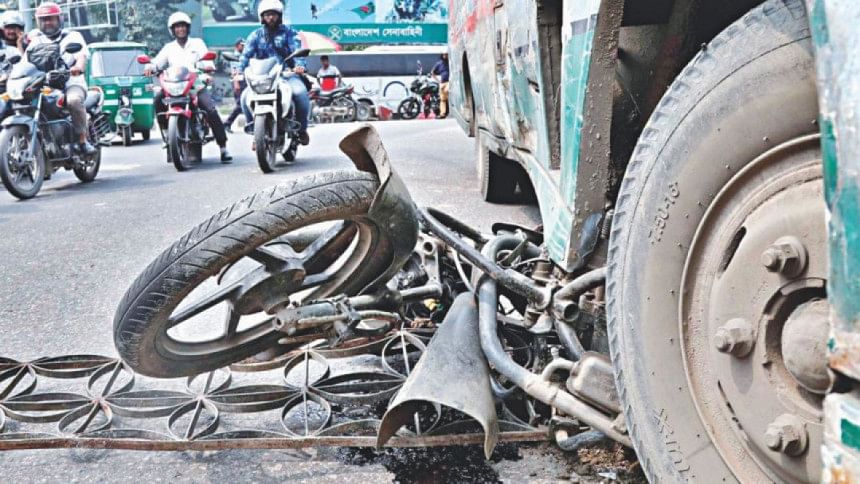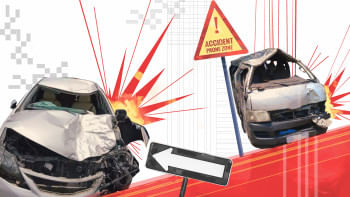Concerted efforts can curb motorbike crashes

Road crashes and their toll on human lives are, unfortunately, everyday news. In fact, they are so common that we have become inured to this tragedy. Usually, we do not pay attention to the news on accidents unless they happen to someone we know.
However, road crashes have escalated to a point where a safe return to home, even from a short visit to the nearest market, is no longer guaranteed. In busiest cities like Dhaka, the situation becomes even more perilous due to heavy, unregulated traffic, queuing of rickshaws, trucks, motorcycles, buses, private cars, and CNG-run auto-rickshaws on the same roads, and the scarcity of safe infrastructure for commuters, including pedestrians and cyclists.
A recent report by the Bangladesh Jatri Kalyan Samity gives a harrowing figure of road mishaps and deaths in the country. According to the report, 503 road crashes took place in the month of February 2024 across the country, causing 555 deaths and 1,031 injuries.
Notably, motorcycle accidents are the highest, causing almost 38 percent of the total accident-related deaths. Adolescents and youths are at a higher risk of being the victims of motorbike crashes. This is because, in both urban and rural contexts, a substantial portion of motorbike users are adolescents, and they tend to drive more recklessly than other motorcyclists. In Dhaka city, more than half (52.65 percent) of registered vehicles are motorcycles, according to Bangladesh Road Transport Authority (BRTA). In upazilas and outskirts, many have no licence at all. The number of motorbikes is sharply increasing, so experts dread that deaths and injuries from motorbike crashes may also rise.
Of the victims of such crashes, many are the breadwinners of poor and vulnerable families. These families fall into a dire situation after losing their earning members—in some cases, the sole earner. Besides, the fatalities include a significant number of women and children. Needless to say, the injured and their families have to bear the brunt of the accidents for a long time, sometimes even a lifetime.
Sometimes, some accidents ignite public anger, and we stage protests, but to no effect. Overall, we are becoming comfortable with frequent, fatal vehicle crashes. Last year, a total of 2,252 people were killed by 2,031 motorbike accidents in the country, according to Jatri Kalyan Samity's annual report. It accounts for 32.43 percent of total accidents.
In light of this grim reality, the question inevitably arises: who bears the responsibility for these crashes?
The reasons behind this situation are well-documented. A significant segment of motorbike users falls within the age range of 14-18 years. They often pressure their parents into purchasing high-speed motorbikes, driven by a desire to outshine their peers who have also acquired similar vehicles. Sadly, this trend has evolved into a competition among parents to demonstrate their capability to provide such luxuries to their children. Consequently, owning a motorbike becomes synonymous with pride and distinction among the youth.
The allure of speed is also a central factor. Many young riders take to local streets and highways at exhilarating speeds, often with fatal consequences. There is a dangerous fantasy associated with the thrill of speeding, exacerbated by the prevalence of racing videos and "moto vlogs" on social media platforms. These videos entice impressionable adolescents to imitate risky behaviours, sometimes leading to catastrophic consequences. Adding to the peril is the lax attitude towards safety gear, such as helmets, further endangering not only their lives but also those of pedestrians and commuters.
Addressing the current surge in hobby-driven motorbike use and the resulting fatal accidents demands urgent attention from all actors involved to safeguard the lives of adolescents, youth, and future generations.
It is imperative for parents to recognise the gravity of the situation and refrain from enabling dangerous behaviour under the guise of fulfilling a hobby. Local bodies, including both government and non-government, must also collaborate to launch comprehensive awareness campaigns highlighting the inherent risks of adolescent motorbike use. Additionally, the government must commit to long-term strategies, such as adopting the "Vision Zero" approach pioneered in Sweden, which aims to eliminate road crash fatalities. This approach can include implementing structural measures, like dedicated lanes for motorbikes and three-wheelers on highways, leveraging innovative technologies, such as speed monitoring systems, and stringent enforcement of speed regulations and road safety protocols. Undertaking thorough research into addressing these recurring tragedies can yield invaluable insights for effective intervention strategies.
While Bangladesh progresses with ambitious, mega-infrastructure projects in the road and transport sector, the persistent scourge of road crashes, particularly involving motorbikes, threatens to mar these achievements. It is high time we confronted this crisis head-on, prioritising the preservation of lives and the well-being of communities across the country.
Md Karimul Islam is research associate at BRAC Institute of Governance and Development (BIGD), BRAC University.
Views expressed in this article are the author's own.
Follow The Daily Star Opinion on Facebook for the latest opinions, commentaries and analyses by experts and professionals. To contribute your article or letter to The Daily Star Opinion, see our guidelines for submission.

 For all latest news, follow The Daily Star's Google News channel.
For all latest news, follow The Daily Star's Google News channel. 





Comments